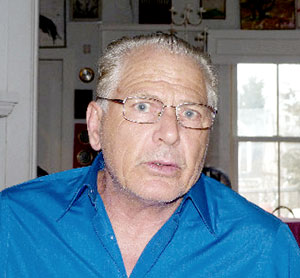
*
Many a Somervillian will be heading to the Cape this summer. I will be heading to that enclave of artists and writers, Provincetown, on the tip of Cape Cod. Christopher Busa, the founder of the magazine Provincetown Arts sent me the latest edition. So I decided to write an appreciation of it.
I have had the pleasure to host Christopher Busa, founder and publisher of Provincetown Arts, at the Ibbetson Street Press Visiting Author Series at Endicott College, where I teach.

Founder/publisher of “Provincetown Arts” magazine, Christopher Busa.
Busa, a man hovering around 70, has an urbane presence, a plethora of anecdotes about artists, writers, academia, and the love of his life Provincetown, MA. This magazine, published annually since 1985, appears every summer, the height of the season for this artist enclave at the tip of Cape Cod. This magazine has beautiful production values (even the ads, especially for the galleries, are candy for the eyes), and the writing is as artful and evocative as the town itself.
The summer 2017 edition is no exception. I told Busa I wanted to write a small piece about the current issue. Busa told me to focus on things that “spoke to me.” So I, of course, pursued the literary offerings. I found that Busa’s piece Alec Wilkinson and the Poetry of Witness spoke very loudly. Wilkinson, a longtime writer for the New Yorker, has written many profiles of people who are off the beaten path. In some ways he reminds me of Joseph Mitchell (and Busa points this out too), the Southern gentleman and New Yorker writer who wrote about Greenwich Village eccentrics (most notably Professor Seagull, a man who claimed he wrote the history of the world in the language of seagulls, and carried his tattered notes on the street with him), bearded ladies, characters he encountered in McSorley’s Bar in NYC, and the flophouses of the old Bowery.
Like Wilkinson’s work, these were not simply journalistic accounts, but they were infused with creative use of language, imagery, etc. Wilkinson told Busa, “I think of myself as a descriptive writer because I don’t think writing divides itself between fiction and non-fiction.” Wilkinson’s non-fiction is infused with poetry.
Wilkinson has written about his year as a Wellflett, MA, police officer. He has written about sugar cane workers. In his book The Riverkeeper he has accounts of men who live by rivers or venture out to the ocean, as well as features about Pete Seeger, Paul Simon and the infamous John Wayne Gacey (who ironically had a distaste for murderers). He is able to capture the authentic way his characters speak. He leaves you with the feeling that real people do talk this way.
Busa points out that Wilkinson is a man who embeds himself with his subjects. Busa compares the writer to the painter J.M.W. Turner, the artist who strapped himself to the mast of a ship to experience a storm. Busa writes about the artist, “He wanted to paint the inner turbulence of the storm itself, rather than view it safely from the shore.” And indeed it seems Wilkinson is able to capture that turbulence in his subjects.
Wilkinson reveals to Busa his experience with the late, longtime fiction editor at the New Yorker, William Maxwell. Maxwell, a well-respected novelist, who acted as a mentor to the young writer. Wilkinson gave this account of Maxwell’s thoughts on the maturation of a writer:
“There is no way to begin as a writer or anything else than by imitation. You find, by chance or design, the works or the philosophies that appeal to you and begin to make use of them. At first it appears that you are no writer (or musician, painter or lawyer) at all, but only a collection of gestures and observations other people have already made and of references to them … they become absorbed, they settle into you, so that instead of being the patterns that determine how your own works sounds or looks or proceeds, they become the technical means you might make use of to describe another person’s face … the weather, the impressions of a landscape…”
The article Downtown on the Beach: The Path from Greenwich Village to Herring Cove, by Brett Sokol, examines current artists’ nostalgia for the less-commercialized sensibility of artists back in the 50s and 60s. Sokol, uses an exhibit at New York University’s Grey Gallery titled Inventing Downtown: Artist-Run Galleries in New York City 1952 to 1965 as a center which spirals out to examine the connection of P-Town and Greenwich Village in that era.
Busa also penned an excellent profile on performance artist Karen Finely, who in her recent work embodies Donald Trump in surreal drag. I found myself in an ongoing conversation with Provincetown Arts, and only fine writing can facilitate that.















Reader Comments